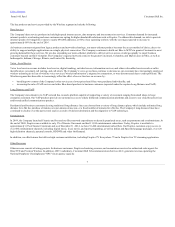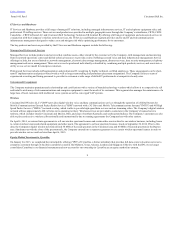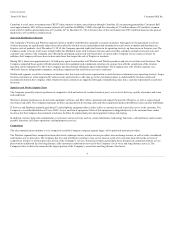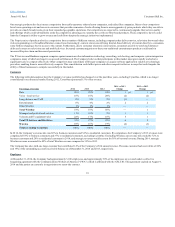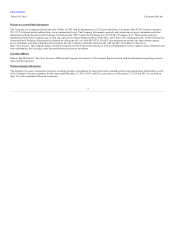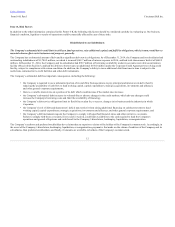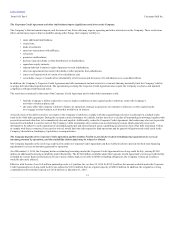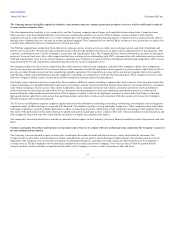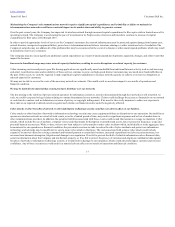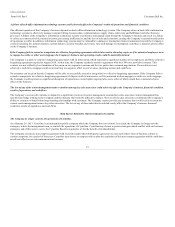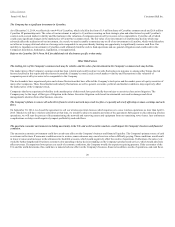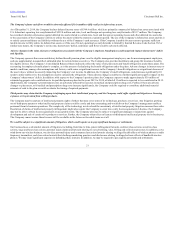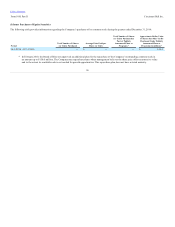Cincinnati Bell 2014 Annual Report Download - page 16
Download and view the complete annual report
Please find page 16 of the 2014 Cincinnati Bell annual report below. You can navigate through the pages in the report by either clicking on the pages listed below, or by using the keyword search tool below to find specific information within the annual report.
Table of Contents
Form 10-K Part I
Cincinnati Bell Inc.
Accelerating the pace of investment in our Fioptics suite of products could have a negative impact on our financial results.
In order to take advantage of a unique opportunity in our market, and due to a progressive change in customer expectations of increased internet speeds,
beginning in 2014 we began accelerating the pace of investment in our Fioptics suite of products, and intend to continue such accelerated investments
through 2016. There are several factors that could result in a negative effect on our revenue, operating income and cash flows, such as:
•
our costs could significantly exceed expectations
•
the acceleration may not generate the expected increase in subscribers
•
it may be inefficient to build out the additional fiber at an accelerated rate
•
there may be a lack of workforce to achieve our construction, sales, and installation targets
•
access to the fiber required for our construction plans may be limited
The Company may be unable to grow our revenues and cash flows despite the initiatives we have implemented.
We must produce adequate revenues and cash flows that, when combined with cash on hand and funds available under our Corporate Credit Agreement and
Receivables Facility, will be sufficient to service our debt, fund our capital expenditures, pay our taxes, fund our pension and other employee benefit
obligations and pay preferred dividends pursuant to our dividend policy. We have identified some potential areas of opportunity and implemented several
growth initiatives, including increasing marketing promotions and related expenditures and launching new products and services with a focus on areas that
are growing such as Fioptics and enterprise fiber-based service offerings. We cannot assure you that these opportunities will be successful or that these
initiatives will improve our financial position or our results of operations.
The Company's failure to meet performance standards under its agreements could result in customers terminating their relationships with the Company or
customers being entitled to receive financial compensation, which would lead to reduced revenues and/or increased costs.
The Company's agreements with its customers contain various requirements regarding performance and levels of service. If the Company fails to provide the
levels of service or performance required by its agreements, customers may be able to receive service credits for their accounts and other financial
compensation and also may be able to terminate their relationship with the Company. In order to provide these levels of services, the Company is required to
protect against human error, natural disasters, equipment failure, power failure, sabotage and vandalism, and have disaster recovery plans available for
disruption of services. The failure to address these or other events may result in a disruption of services. In addition, any inability to meet service level
commitments or other performance standards could reduce the confidence of customers and could consequently impair the Company's ability to attract and
retain customers, which would adversely affect both the Company's ability to generate revenues and operating results.
The Company generates a substantial portion of its revenue by serving a limited geographic area.
The Company generates a substantial portion of its revenue by serving customers in the Greater Cincinnati and Dayton, Ohio areas. An economic downturn
or natural disaster occurring in this limited operating territory would have a disproportionate effect on the Company's business, financial condition, results of
operations, and cash flows compared to similar companies of a national scope and similar companies operating in different geographic areas.
A large customer accounts for a significant portion of the Company’s revenues and accounts receivable. The loss or significant reduction in business from
this customer would cause operating revenues to decline significantly and have a materially adverse long-term impact on the Company’s business.
As of December 31, 2014 and 2013, the Company had receivables with one large customer that makes up 26% and 19% of the outstanding accounts
receivable balance, respectively. This same customer contributed 14% to consolidated revenue for the year ended 2014. Contracts with this customer may not
sufficiently reduce the inherent risk that the customer may terminate or fail to renew their relationships with the Company. As a result of customer
concentration, the Company's results of operations and financial condition could be materially affected if the Company lost this customer or if services
purchased were significantly reduced. If this customer were to default on its accounts receivable obligations, the Company would be exposed to potentially
significant losses in excess of the provisions established. This would also negatively impact the available borrowing capacity under the Receivables Facility.
16



